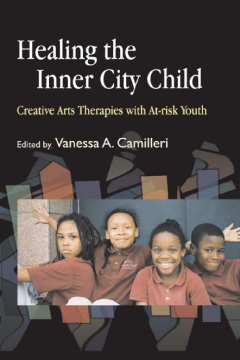
BOOK
Healing the Inner City Child
Daniel Summer | Laura Soble | Suzannah Scott-Moncrieff | Priyadarshini Senroy | Sonali Senroy | Maria Hodermarska | Craig Haen | Mary O'Brien | Linda Odell | Dorothy McGuire | Janet Long | Susan Kierr | Juliane Kowski | Mary O''Brien | Flossie Ierardi | Mark Bottos | Ashley Dorr | Vanessa Camilleri | Diane Austin | Tian Dayton
(2007)
Additional Information
Book Details
Abstract
Healing the Inner City Child presents a diverse collection of creative arts therapies approaches to meeting the specific mental health needs of inner city children, who are disproportionately likely to experience violence, crime and family pressures and are at risk of depression and behavioural disorders as a result.
The contributors draw on their professional experience in school and community settings to describe a wide variety of suitable therapeutic interventions, including music, play and art therapy as well as psychodrama and dance/movement approaches, that enable children to deal with experiences of trauma, loss, abuse, and other risk factors that may affect their ability to reach their full academic and personal potentials. The contributors examine current research and psychoeducational trends and build a compelling case for the use of creative arts therapies with inner city populations.
A must-read for creative arts therapists, psychologists, social workers and educators, this book offers a comprehensive overview of arts-based interventions for anyone working to improve the lives of children growing up in inner city areas.
This book is an act of love and dedication and supplies a valuable resource for clinicians, educators, researchers, and students in creative arts therapies and other related human service professions. Given the state of our world, and the plight of youth in our inner cities, it supplies hope, and indeed, makes one proud to be creative art therapist.
American Dance Therapy Association
I believe that this book is an incredibly useful resource for those of us who work with children at risk: it certainly puts arts therapist on the map. I would recommend this book as an extremely useful resource offering sound research, clear definitions and useful examples.
Sesame Institute Journal
As one of the first educations in the fields of art, music, and dance/movement therapy, I recommend this book to educators, students, and practitioners. The case studies are moving, the implementation of the arts therapies professional and inspiring, and the personal observations insightful. This work is a wonderful testimony to the uniqueness, power, and validity of the creative arts therapies.
The Arts in Psychotherapy
The contributors use their professional experiences to set out a wide variety of therapeutic interventions such as art, music, drama, and dance therapy, that help children to deal with traumatic experiences and loss in their lives. This particular approach to helping inner city children is based upon the belief that such children are at particular risk of future depression and behavioural problems given their increased exposure to pollution, and instances of violence and crime.
Child Right
The writing style allows accessibility for a wide range of readers. There are excellent references and subject index, with good signposting for the reader who wants to dip into the book. This is worth reading for the political argument for intervention at a global level and the psychodynamic understanding of life... This should be read by Managers of Children and Young People's Directorates and managers of Social Care and Local Service teams. Also any practitioners in multi-agency teams working directly with vulnerable families and young people would appreciate the book.
British Psychological Society
This two-part book exposes the reader to professionals who use creative arts therapies and related modalities in working with urban youth. I highly recommend this text to art therapists who are interested in working with urban young people, or who are currently doing this rewarding and challenging work. Camilleri provides a solid foundation for understanding the complexity of this population, and the contributing authors bring a human face to an often underrepresented population.
Journal of the Art Therapy Association
